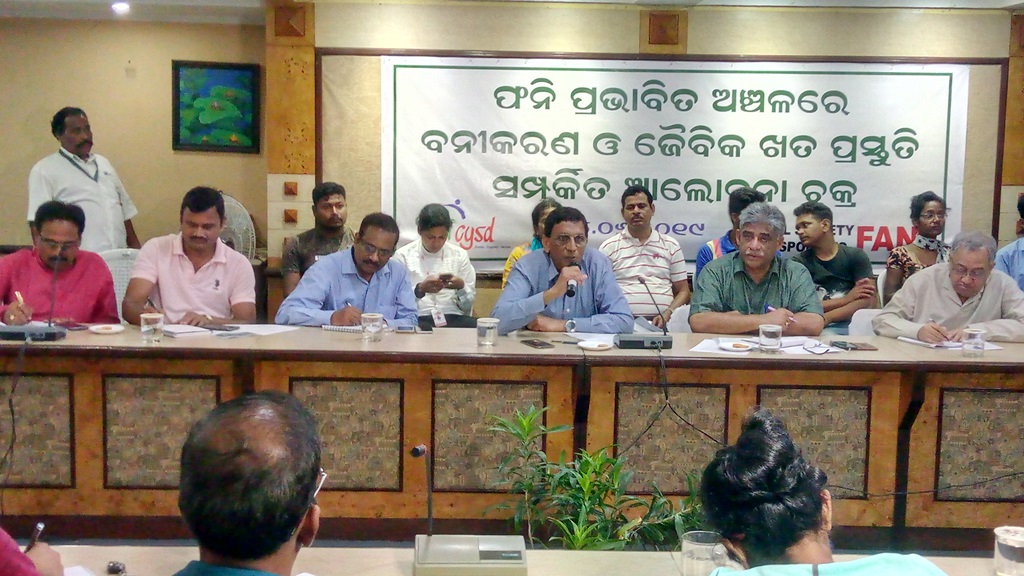Collective effort required to restore greenery after cyclone Fani
Massive plantation through convergence mode is the need of the hour to compensate green loss
Bhubaneswar: “Even as severe cyclonic storm Fani has damaged millions of trees in the state, it is high time we thought of cyclone-resilient trees as cyclones are likely to be more frequent in the near future so far as the current scenario of global warming and Odisha’s vulnerability to climate change is concerned,” said eminent environmentalist Professor Radhamohan.
He was addressing a consultation programme on “Restoration of Greenery post-Fani” attended by senior officials of Forest Department, Directorate of Horticulture, Coconut Development Board and Cashew Research Station, environmentalists and Civil Society representatives to prepare a Green Road Map for the state. The consultation was organised by the Civil Society Responds to FANI (CSRF), a group of civil society organisations and the Centre for Youth and Social Development (CYSD).
He suggested that cyclone-resilient trees like neem, Patali, Saptaparni, Pesta Badam, Arjuna, Jamun, Kusum, Ou, Sunari, tamarind, Acacia Mangium, Chironjee, Champa, and Kanchana should be considered for avenue plantation. Besides, species like cashew, casuarina, acacia auriculiformis, sissoo, bamboo, American Silk Cotton can be considered for commercial plantation. He also urged the government to think about the regeneration of damaged trees and replantation of uprooted trees. Describing different regeneration methods he said while branches of banyan tree can be planted, bamboo can be grafted.
As the affected people are now planning not to plant trees near their houses, he said, there is no problem in planting trees near houses, however, planting big trees should be avoided on the North direction of a house. It is because the direction of the wind is generally North-East or North West during cyclones.
“Massive plantation through a convergence mode is the need of the hour to compensate the green loss,“ said Jagadananda, Founder and Mentor of CYSD. This requires collective action from the government, civil society organizations, community-based organizations, and corporates. He lamented that the trees which survived the 1999 Super Cyclone were damaged by Fani. He also shed light on the preparation of bio-manure from plant residue, setting up of decentralised nursery and mass plantation drives. Besides, reviving livelihood of affected people who suffered crop loss and other losses should be the priority, he added.
Speaking on the road map of restoration by the govt, Dr. Sandeep Tripathy Principal Chief Conservator of Forest (PCCF) said, “Plantation drive will be undertaken on around 6000 hectares of land in the next 5 years. The area includes coastal belt, forest land, and roadsides. Around 50 lakh seedlings will be distributed free of cost and around 25 lakh seedlings out of this will be planted in urban areas. He proposed for plantation of casuarina trees that are disaster resilient and protect the environment by reducing wind velocity. Besides, they are also commercially beneficial. While there is a dearth of disaster-resilient saplings in the state, the government has planned to seek support from neighboring states, he added.
Environmentalist Sabarmatee urged the people of affected areas not to burn the fallen trees and leaves. She said those plant residues are actually bio-resource and can be used in the preparation of bio-manure. She explained the method of preparation of bio-manure.
Sarpanch of Talamala panchayat Trilochan Behera shared the colossal loss of trees the people of his panchayat suffered. He said the economic backbone of the panchayat was broken due to damage of thousands of trees like casuarina, coconut, banana, cashew and several other trees which have their immense ecological importance.
Former Chief Secretary, Odisha & Union Secretary of Rural Development Jugal Mohapatra focused on initiatives for revival and transplantation of damaged plants. He urged the civil society to play a proactive role to anchor the process and suggested that funds from CAMPA can be mobilized for the purpose. Schemes like Pradhan Mantri Gram Sadak Yojana and MGNREGS can be utilised to support the green drive and concentrate the human, technical and financial resources.
Among others, Aurobindo Behera, former Odisha State Disaster Management Authority (OSDMA), Director of Horticulture, Members of Coconut Development Board, Additional Commissioner Bhubaneswar Municipal Corporation, affected farmers, panchayat representatives and volunteers discussed on the colossal loss of green cover. They maintained that the destructive gale uprooted at least 20 lakh trees in the capital city alone while Puri, Khurda, and Cuttack districts have been badly affected by the storm. More than 50 percent of trees have been uprooted in Balukhanda sanctuary of Puri Coast alone. Further, horticulture has also been badly affected in areas like Satapada, Krushnaprasad, Brahmagiri, Gop, Satyabadi, Nimapara, Pipili and several blocks of Puri district and in Bhubaneswar and Cuttack. Coconut and cashew plants, a major source of livelihoods in the coastal region, are also severely damaged.
Also read: Lok Sabha MP Dr. Achyuta Samant Visits Baliguda In Kandhamal




 Kalinga AI
Kalinga AI